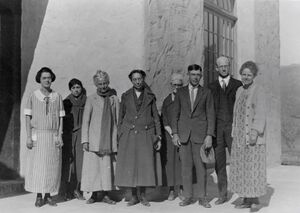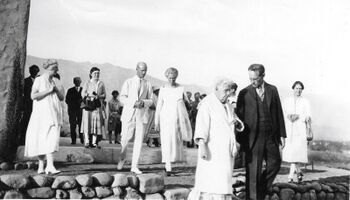Eugene Munson
Eugene W. Munson was a member of the American Theosophical Society and lecturer for the Krotona Institute of Theosophy.
Personal life
On November 9, 1877, Eugene Webster Munson was born in Marshall, California to Miron Munson and Fannie Aldrich Munson.[1] He had two older sisters and one younger brother. By 1880, the family had moved to Spokane, Washington.[2] Little is known of the life of Miron, but by 1900, Fannie had remarried to Joseph E. Cohenhour. They lived in Chicago with three of the children, including Eugene, who at age 23 was working as an electrician.[3]
At some point Eugene moved to Roswell, Idaho, a small town near Boise, where he was part owner of a general store, and regarded as "one of the substantial citizens of that community."[4] On August 1, 1908, he married Mattie Doll of Saugatuck, Michigan, and they moved into a well-furnished bungalow.
Theosophical Society activities
Munson joined the San Buena Ventura Lodge of the American Theosophical Society on October 10, 1904. In 1909-10 he became president of the newly formed branch in Salt Lake City.[5] He was temporarily lodging in Utah and working as a draftsman, while lecturing weekly at Theosophical meetings.[6]
Krotona in Hollywood
In late 1912, he disposed of his Idaho property, including a ranch, and in early 1913 moved to Krotona in Hollywood.[7][8] As the local newspaper reported:
Mr. and Mrs. Eugene Munson will soon leave for Krotona, California, near Los Angeles. Mr. and Mrs. Munson are moving so as to be near the new headquarters of the Theosophical society. They are thoroughly devoted to the Theosophical cause and feel it their duty to take a move active part in the work at Krotona.[9]
He wrote articles for Theosophical periodicals, such as "Tesla's Wireless Power and Mr. Leadbeater's Prophecy"[10] He demitted to the Krotona Lodge in 1917.[11] Beginning in 1917, he served as treasurer of the national Society.[12]
During the Hollywood years of Krotona Institute of Theosophy, Eugene Munson helped to arrange activities for the many visitors:
It is becoming the custom for members of the Society living in nearby towns, to come to Krotona for their vacations. Here they may enjoy the soft climate of our Hollywood hills, pleasant even during the summer months, and attend the lectures of the krotona institute of Theosophy, as well as assist in the work in the offices. Weekly excursions to the beaches or mountains, arranged for by Mr. Eugene Munson, are indulged in by the visitors and students.
Mattie Munson also worked for the Institute as a printer and multigrapher. When the Besant Lodge of Krotona was established in October 1920 with 56 members, Eugene was a charter member and vice president, with Marie Poutz as president.[13] In 1922 he coordinated a national campaign to relieve hardships of Russian Theosophists, raising over $600.[14]
Krotona in Ojai
Munson was instrumental in moving the Krotona Institute from Hollywood to Ojai, California. The Munsons were the first residents at the new Krotona, initially living in the Kerfoot Ranch House while supervising construction of the new buildings.[15] For many years he assisted George Hall in managing the estate.
Lecture tours
After Krotona had become established in Hollywood, Munson became more active in the national organization. George H. Hall, Manager of the Krotona Estate, wrote:
Later he entered the service of The Theosophical Society in America as a National Lecturer, and traveled throughout the United States lecturing and organizing study classes and lodges. He was one of the best lecturers for the Society and made many friends all over the country. It was from this work that I called him in 1923 to help me at Hollywood before we moved to Ojai. When we sold the Hollywood property, he and Mrs. Munson were the first to move to Ojai, and for nearly thirty years we have worked together to build the new Krotona in the Ojai Valley.[16]
During the years 1916-1922, Munson worked as a National Lecturer of the American Theosophical Society, touring for months on end. In the years 1919-1920, for example, he lectured in at least 50 cities of 19 states and Canada.[17] His presentations received excellent reviews from local newspapers. After speaking in Pueblo, Colorado, a reviewer wrote:
Mr. Munson has just competed a very successful course in Denver, speaking to capacity houses. He is a pleasant speaker and uses anecdotes, stereopticon and blackboard illustrations freely in demonstrating the more unfamiliar phases of his subject.
He appears practical and level-headed, being an engineer by profession.[18]
During the First World War, he often lectured about topics related to current events, such as an occult view of the war and the rebirth of those who died in wartime in his lecture "What Comes Out of the War;" "The Occult Relations of France, Great Britain, and the United State;" and "The New International Ship of State" [referring to the League of Nations].
Usually Munson spoke more directly about Theosophical subjects, using the stereopticon slides of thought forms and the astral body developed by C. W. Leadbeater. Titles included "How Many Lives Have You Lived?," "Do the Dead Return," "The Path of Achievement," "The Inner Gates of the Soul," and "The Science of the Borderland" [Theosophical explanations of spiritualistic experiences]. A reviewer in Great Falls, Montana, wrote of "The Hidden Side of Things":
In the course of his address, which was heard by a large gathering of interested men and women, Mr. Munson described how telepathy is possible, explained what thoughts are, showing them as tangible objects, with shape and color visible to the occult eye. Mr. Munson also dealt somewhat at length on the evolution of the soul toward perfection.
The lecture was the first of a series of four to be given here... The purpose of the lectures is to arouse interest in the science of theosophy with the idea of perfecting an organization in this city.[19]
In 1939, he assisted Marie Russak Hotchener, Marie Poutz, Henry Hotchener, and Eugene Wix in conducting a dedication of new lodge rooms at the Compton Lodge.[20] Munson had helped to organize that lodge.
Other activities
George Hall wrote:
In addition to his interest in Krotona and its activities, he took a keen interest in public affairs, and was always generous with his time and contributions to many outside interests. He did much to acquaint the people of the Valley with Krotona an to win for us the respect and friendliness of the community.[21]
Eugene Munson was a 32° Co-Mason.
Later years
Munson continued lecturing from time to time, and also spoke in live radio programs.[22] At the time of his death in 1952, Munson was a member of the Krotona Board of Trustees. He died on October 31, 1952 in Los Angeles.[23]
Notes
- ↑ 1926 Passenger list...........
- ↑ 1880 United States Federal Census.
- ↑ 1900 United States Federal Census.
- ↑ "A Roswell Wedding" Caldwell Tribune 29 (August 1, 1908): 2.
- ↑ "Salt Lake City" The Theosophic Messenger 11 no. 10 (July, 1910): 633.
- ↑ 1910 United States Federal Census.
- ↑ Caldwell Tribune 29 (December 20, 1912): 4.
- ↑ Untitled article. Caldwell Tribune 30 (January 10, 1913): 7.
- ↑ Untitled article. Caldwell Tribune 30 (January 3, 1913): 4.
- ↑ "Eugene W. Munson, "Tesla's Wireless Power and Mr. Leadbeater's Prophecy" The Messenger 3 no. 6 (November, 1915): 164-165.
- ↑ Membership Ledger Cards roll 5. Theosophical Society in America Archives.
- ↑ Eugene W. Munson. "Treasurer's Report" The Messenger Statistical Year Book supplement 5 no. 4 (September, 1917): 4.
- ↑ "Besant Lodge, Krotona" The Messenger 8 no. 7 (December, 1920): 577.
- ↑ "Relief of Russian Theosophist" The Messenger 10 no.1 (June, 1822): 12.
- ↑ Elena Doval Santos email to Janet Kerschner. August 20, 2023. Theosophical Society in America Archives.
- ↑ "Mr. Eugene W. Munson" The American Theosophist 40 no. 12 (December, 1952): 240.
- ↑ See multiple references in The Canadian Theosophist 1 no. 1-4 (March-June 1920).
- ↑ "Lecture Course in Theosophy" Pueblo Chieftain (March 12, 1922): 6.
- ↑ "Theosophists Plan to Organize Here" Great Falls Daily Tribune (September 12, 1921): 9.
- ↑ "Compton Lodge Dedicates New Home" The American Theosophist 27 no.12 (December, 1939): 287.
- ↑ "Mr. Eugene W. Munson" The American Theosophist 40 no. 12 (December, 1952): 240.
- ↑ "San Buenaventura" The American Theosophist 37 no.5 (May, 159(: 101-102.
- ↑ 1952 California, U.S., Death Index, 1940-1997.

